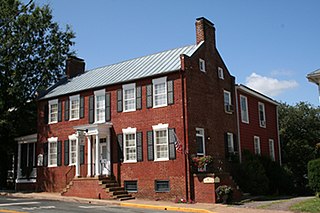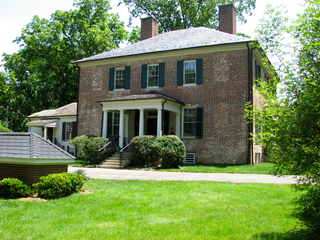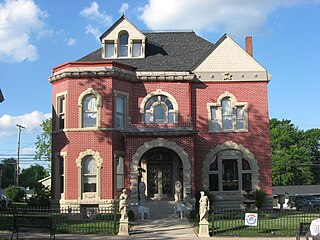
Highland, formerly Ash Lawn–Highland, located near Charlottesville, Virginia, United States, and adjacent to Thomas Jefferson's Monticello, was the estate of James Monroe, fifth President of the United States. Purchased in 1793, Monroe and his family permanently settled on the property in 1799 and lived at Highland for twenty-four years. Personal debt forced Monroe to sell the plantation in 1825. Before and after selling Highland, Monroe spent much of his time living at the plantation house at his large Oak Hill estate near Leesville, Virginia.

Piney Grove at Southall's Plantation is a property listed on the National Register of Historic Places in Charles City County, Virginia. The scale and character of the collection of domestic architecture at this site recalls the vernacular architectural traditions of the eighteenth, nineteenth and twentieth centuries along the James River.

Graeme Park is an historic site and National Historic Landmark at 859 County Line Road in Horsham, Montgomery County, Pennsylvania. It is owned by the Pennsylvania Historical and Museum Commission and operated by the non-profit group, The Friends of Graeme Park. It is the only surviving residence of a colonial-era Pennsylvania governor. Graeme Park was constructed in 1722 by Sir William Keith as a summer residence and alternative to his governor's mansion at Shippen House on Second and Spruce Streets in Philadelphia. The house, originally known as Fountain Low, has been largely unchanged since its construction except for a restoration by Dr. Thomas Graeme in the mid 18th century and a minor restoration by the Pennsylvania Historical and Museum Commission in the 1960s. Graeme Park at 859 County Line Road in Horsham is open to visitors on Friday and Saturday 10:00 a.m. until 4:00 p.m. and on Sundays from noon until 4:00 p.m.

Greenwood Farm is a historic property and nature reserve located in Ipswich, Massachusetts, which is owned by The Trustees of Reservations. It features the Paine-DodgeHouse, a First Period farmhouse constructed in 1694.

Formerly called the Doctor Holladay House, the Holladay House in Orange, Virginia is on the nationally recognized Journey Through Hallowed Ground. Named for Dr. Lewis Holladay, a prominent Virginia physician, the Holladay House has witnessed almost two centuries of American history. The building is historically significant because it is one of only a few antebellum structures still standing in Orange, Virginia.

Jackson Place is a Washington, D.C. street located across from the White House and forming the western border of Lafayette Square between Pennsylvania Avenue and H Street, NW, beginning just south of Connecticut Avenue.

Huntley, also known as Historic Huntley or Huntley Hall is an early 19th-century Federal-style villa and farm in the Hybla Valley area of Fairfax County, Virginia. The house sits on a hill overlooking Huntley Meadows Park to the south. The estate is best known as the country residence of Thomson Francis Mason, grandson of George Mason of nearby Gunston Hall. It is listed on the National Register of Historic Places (NRHP), the Virginia Landmarks Register (VLR), and the Fairfax County Inventory of Historic Sites.
Okeley Manor was an early 19th-century plantation in Fairfax County, Virginia, United States. Okeley, the residence of prominent Alexandria physician Richard Chichester Mason (1793–1869), was one of the principal Mason family estates in Northern Virginia. Mason' plantation house was used as a hospital during the American Civil War and burned to prevent the spread of smallpox.

Holt House is an historic house, located on the grounds of the National Zoo, and probably built before 1814. It is one of the most important examples of early Neoclassical architecture in Washington, D.C., and was one of the major houses in the new Federal City when it was built. Its caretaker has been the Smithsonian Institution since 1889, and is the oldest building under the Smithsonian's auspices, but has been left vacant since the 1980s. It was listed in the D.C. Inventory of Historic Sites in 1964 and was placed on the National Register of Historic Places on April 24, 1973.
Holt House has a long history of being in a bad state of repair. Its present condition is bad, and it was in a deteriorated condition when purchased by the Smithsonian in 1890.

The Dr. Leonard Hall House was a private resident located at 334 West Main Street (M-34) in Hudson in westernmost Lenawee County, Michigan. It was designated as a Michigan Historic Site on April 4, 1978 and later added to the National Register of Historic Places on October 2, 1978.

The Francis Land House, or Rose Hall, is a historic brick house in located within the Rose Hall District near Princess Anne Plaza in Virginia Beach, Virginia. It was the plantation home of the prominent Land family, a founding family of Princess Anne County, Virginia.

Bennett Cockayne House is a historic home located at Glen Dale, Marshall County, West Virginia. It was built about 1850, in a vernacular I-house style. It is a two-story, wood-frame building with wooden clapboard siding and a slate roof. Also on the property are a contributing supply shed and water pump. It was listed on the National Register of Historic Places in 2002.

Bloomsbury Farm was an 18th-century timbered framed house, one of the oldest privately owned residences in Spotsylvania County, Virginia. The house was originally built by the Robinson family sometime between 1785 and 1790. It was architecturally significant for its eighteenth-century construction methods and decorative elements. The surrounding location is also significant as the site of the last engagement between Confederate and Union forces in the Battle of Spotsylvania Courthouse on May 19, 1864. Bloomsbury Farm was added to the National Register of Historic Places in May 2000. The house was demolished in December 2014 by Leonard Atkins, a nearby resident who purchased the property in November 2014 ostensibly to restore it. Atkins cited the building's supposedly poor condition and public safety as the reasons for the abrupt demolition, and he planned to replace the historic house with a new one commensurate in style and value with the modern houses in the surrounding development in which he lives. The farm was removed from the National Register in 2017.

Fall Hill is a plantation located near the falls on the Rappahannock River in Fredericksburg, Virginia. Though the Thornton family has lived at Fall Hill since the early 18th century, the present house was built in 1790 for Francis Thornton V (1760–1836). The land on which Fall Hill is located is part of an 8,000 acres (3,200 ha) land patent obtained by Francis Thornton I (1657–1727) around 1720. The present-day town of Fredericksburg, Virginia is located on that original patent.

The Oram Nincehelser House is a historic residence in the village of Mechanicsburg, Ohio, United States. Built for a nineteenth-century local doctor, it has been named a historic site because of its distinctive architecture.

Black Walnut is a historic plantation house and farm located near Clover, Halifax County, Virginia. The main house was built in at least three sections beginning about 1774 to 1790. In the 1840s and 1850s, a substantial two-story frame addition was built in two stages parallel to the existing house, along with a connecting hyphen, together giving the house an overall "H"-shape. The interior features Greek Revival style details.
James Innes Thornton was a prominent Alabama, USA, planter and politician.
Lt. Francis Thornton of Rolling Hill was a planter and soldier during the American Revolutionary War. Thornton served as cornet of Lee's Legion of Light Dragoons commanded by Major-General Henry "Light-Horse Harry" Lee. Thornton went onto serve as a lieutenant in the Charlotte County Militia in the later part of the Revolution. Thornton was the son of William Thornton a Burgess for Brunswick County, Virginia and a great-great-grandson of William Thornton who arrived in Virginia from England as late as 1646 settling in Gloucester County, Virginia. Thornton was commonly known as "Frank Thornton" as indicated in the historical record and often referred to as "Francis Thornton of Rolling Hill" to differentiate him from his cousins Francis Thornton of Fall Hill and Francis Thornton of Society Hill. Thornton was a distant cousin of Presidents James Madison and Zachary Taylor.
Richard Thornton may refer to the following people:



















